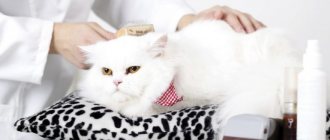7785Administration
Many owners of sterilized four-legged friends are very interested in whether a neutered cat can mate with a cat. In reality, this happens quite often. But only taking into account the fact that the pet has already had experience in sexual activity. If we take any other situations, then this is excluded.
Some veterinary clinics keep such cats in order to mate with females, knocking down the desire. As a result, it turns out that both animals received satisfaction of instincts, but without consequences in the form of offspring.
If the cat has not mated before the procedure, it is likely that he will not show any interest after it. Often they simply forget about their adventures and natural call, living a full and active life.
It also happens that a neutered cat may demand a cat. Don't worry about it, because everything is easily explained. After surgery, the animal’s body retains a fairly large level of testosterone, which will go away over time. Therefore, owners just need to stock up on a little patience and try to limit meetings with the opposite sex.
Reasons for attraction to females
How can you live without such touching creatures as cats? While the animal is small, it brings a lot of positive emotions and impressions. But when he grows up, problems begin, as natural intuition takes precedence over creation.
© shutterstock
And then only one thought comes to mind - castration or sterilization. Many people believe that castration can solve all the nuances. But there are also opposite cases when the procedure does not bring positive results. Causes:
- The cat had already mated with a female before castration;
- Unfair operation;
- Little time has elapsed.
In the first case, after sterilization the cat did not completely lose interest in the cat. It’s just that on a physiological level he cannot do this, since he has already had intercourse. After castration, sex hormones will continue to be produced , leading to repeated heart-rending cries, territory marking, and desires to mate. This is why veterinarians advise carrying out the procedure until a certain age.
The second place is occupied by unqualified specialists. There is such a thing as cryptorchidism. This is when the male has one testicle in the scrotum and the second in the abdomen. Professional doctors will be able to determine this instantly, but unscrupulous ones may remain silent, performing castration as they please.
If the owner wants to get rid of the torment once and for all, he should only contact trusted clinics to avoid falling for scammers.
A castrated cat may continue to want to mate if little time has passed after the procedure. This period can last for a week, since hormonal levels do not disappear instantly. Owners need to be patient and understanding.
Can a neutered cat mate with a female cat?
After the procedure, the pet may periodically tear up the furniture.
According to veterinarians, the pet often climbs and attacks the female within 2 months after castration. Interest before mating gradually decreases, but mostly does not disappear completely. At first, the cat hunts the cat, sometimes scratches the furniture, meows heart-rendingly and marks the territory. It is recommended to protect the animal from representatives of the opposite sex. A castrated cat can get along with a female, but he may still have interest in the lady. If pets have sex, offspring will not appear.
Why do I sterilize?
People living in apartments with their beloved pets have a very difficult time going through puberty, the so-called mating period. The four-legged friend begins to behave very aggressively, scratching furniture and doors.
But what’s more terrible is when he marks the territory with rather unpleasant odors, plus he always meows as if he’s being cut. Is it possible to live normally in such dizzying conditions?
And cats that have free access to the street may disappear for a week. And they will not return until they fulfill their calling. Because of all this, owners decide to sterilize the furry one.
© shutterstock
What to do if a cat wants a cat after castration
The situation arises when several animals of the opposite sex live in the same room. If the owner does not like that the castrato is trying to cage and there are several rooms allocated for the needs of cats, the animals are seated. If a male who has recently been castrated shows interest, hormonal contraception is used. A veterinarian will help you choose the right remedy. If the layout of the apartment allows, animals of different sexes are seated during estrus.
Be sure to read:
How to care for a cat after sterilization: blanket, diet, treatment and removal of sutures
Despite the fact that the pet’s behavior does not suit the owner, the pet cannot be punished. Otherwise, a stressful situation will arise in which the animal becomes aggressive.
To distract the animal from acquired habits, it is occupied in the following ways:
- Expansion of vertical territory. The cat wants to have safe places for rest and entertainment. Beds are placed on the window, shelves are attached to the walls, as well as hammocks. The cat climbs on a hill and feels comfortable.
- Using a scratching post will protect upholstered furniture, allow the cat to relax and relieve stress.
- Interactive toys increase physical activity and distract from other activities.
- If there are several cats in the apartment, you need to place a feeder and tray for each in different places.
In some situations, the owners themselves provoke the cat into inappropriate behavior. Stroking and squeezing the animal affects the erogenous zones, and the pet becomes excited. At such moments you should stop communicating.
Pros and cons of castration
Naturally, every owner of a four-legged friend has his own opinion about castration. But there are also conclusions from veterinarians on this matter.
Positive sides:
- Not always, but in most cases, the male stops marking the territory;
- The open front door no longer attracts him at all;
- Good nights for the owner, as the cat does not meow when asking for a cat;
- The risk of contracting numerous diseases is greatly reduced;
- Your favorite animal will live several years longer.
Negative aspects also occur:
- Sometimes lethargy appears and laziness awakens;
- Fluffy may gain weight;
- Habits of marking territory may remain (but this is rare);
- Even less common is uncontrolled aggression and the desire to mate.
Gulena cat: all the subtleties of the process
There is an opinion that a cat wants a cat in the spring, or more precisely, in March. And it is true... in relation to the “correct” cats living “in nature”. Natural laws tell them to walk in the spring, feed their offspring in the warm season, and in the cold, think only about survival. Unfortunately or fortunately, the sleek, mustachioed pets who live in our homes look down on this opinion. A sweet life and a good diet lead to the fact that they are ready to reproduce throughout the summer and autumn months, and even winter.
At what age does a cat start asking for a cat?
What time do cats start walking? It depends on its breed: usually a cat begins to ask for a cat for the first time in the sixth to tenth month of life. However, despite the onset of puberty before the age of one year, she is not always able to give birth to healthy babies at this time. If a cat wants a cat for the first time, it is advisable not to let them meet at least until the age of one and a half years.
Signs of estrus in a tailed “bride”
What signs in an animal's behavior indicate that a cat wants a cat? There are a lot of them, and it’s difficult not to notice the signs that a cat has gone on a spree:
- the cat screams both day and night, trying to run away from the house;
- cannot stay in one place;
- cuddles up to people and rubs against objects;
- calm cats become aggressive, and vice versa;
- rolls on the floor, lifts its tail up or to the side, tramples with its hind legs, as if squatting on them;
- loses appetite or almost refuses to eat;
- noticeable discharge from the genitals;
- urination becomes more frequent.
How often does a cat ask for a cat?
How many days does a cat walk? The duration of her estrus varies from person to person. But the end of this period, when the cat has gone on a spree, does not mean at all that the owners can relax for a long time: if the “bride” did not manage to meet the “groom”, screaming and rolling on the floor can resume after a week or two. And to the question “how many days does the cat ask for the cat?” the exhausted owners answer: “all 365 in a year!” How this looks in practice, look at the video (Alexey Karasev).
How long does a cat walk?
How long does the cat ask for the cat? The duration of estrus is usually from 7 to 20 days. If the “bride” does not become pregnant, then the “wedding requirements” will be repeated every 14-21 days until she is expecting children or the resting season begins. Occasionally, a third option is also possible, the so-called false pregnancy, which postpones the appearance of a new period when the cat wants a cat.
Stages of heat
The estrus process can be roughly divided into four stages.
- The first is called proestrus. It lasts from 1 to 4 days and is characterized by the relative calm of the animal. The beginning of the period when the cat went on a spree is indicated only by quiet throaty meows and obsessive caressing of the owners. The tailed cat is not yet ready to meet a roaming cat.
- The second period, estrus, can last 7–10 days. The female begins not just to scream, but to scream at the top of her lungs. When you stroke her back, she crouches, moving her tail to the side. This means they are ready to mate. If you want to let her have a kitten or several, it is better to bring a male on the 3rd-5th day of estrus.
- In the third period, metestrus, which lasts from 3 to 12 days, the pet that has walked with the “groom” will drive away all applicants. When fertilization does not occur, a false pregnancy may begin, very similar to the real one, but not ending in childbirth. True pregnancy in your pet lasts 60–70 days.
- In the last, fourth period, called anestrus, she calms down.
The myth of fatness
Yes, a neutered cat becomes much calmer, but this does not mean that he will gain weight.
After castration, metabolic processes in the body slow down, so high-calorie food will harm the animal. There is a chance to earn:
- Fatty liver degeneration;
- Cardiovascular failure.
To avoid obesity, you should adhere to proper nutrition and give your pet the prescribed portions of food.
There are companies that produce special dietary foods for sterilized individuals. They are low in calories, plus, prevention for the genitourinary system. The daily dosage is written on each package. Don't neglect valuable advice.
© shutterstock
Of course, you can feed natural products, but it will be difficult to calculate a balanced diet. It is recommended to exclude fish from the diet altogether. Since the contained mineral salts can lead to urolithiasis. The basic requirements are to feed your pet the prescribed amount of food in order to maintain normal physical shape.
But in fact, only the owners are to blame for the obesity of neutered cats. Since they do not find time to play with a friend, replacing attention with something tasty.
In the end, it all depends on the owner, if he treats the furry one with all the appropriate rules, then the animal will not be able to gain weight.
Behavior problems
When cats ask for a date with a cat, household members have a hard time. The constant screaming makes it impossible to sleep at night. Some people can’t stand it and lock their pets in one of the rooms. Others wet the animal’s fur with water in the evenings. This allows you to gain an hour of silence while the cat licks its fur coat. But as soon as she dries up, she starts asking for the cat again. This behavior is exhausting and forces you to try different ways.
Is it possible to calm a cat at home?
Simply petting and calming a cat that asks for a cat is unlikely to work. You will have to be patient and wait until the heat ends.
Numerous “folk” tips on how to calm a pet usually turn out to be ineffective:
- Pet your pet more often. Showing attention will only increase arousal.
- Give sedatives. They will not help because the animal is not stressed. They are driven by the instinct of reproduction. Such medications only slightly dull the desire to mate.
- Feed the cat with products containing pheromones like Feliway. During sexual hunting they are completely useless. Such drugs help to quickly adapt to a new place and to endure the trip more calmly, but they do not pacify natural instincts.
Calming medications for cats
Sometimes veterinarians recommend taking sedatives. Such medications help to dull arousal a little, but their main purpose is to achieve mental lability, eliminate aggression and anxiety.
List of drugs and method of use:
- Cat Baiyun. A medicine based on herbs with a sedative effect - valerian roots, oregano, sweet clover, mint, motherwort, hop cones and others. As soon as the cat begins to ask for a cat, she is given 2 ml of medicine three times a day for 5-7 days.
- Fitex drops. A sedative with herbal components – valerian, motherwort, hop extract. The medicine normalizes the functioning of the central nervous system, muffles the feeling of fear and aggression. If a cat wants a cat, or vice versa, then the pet is given 3-5 drops of the product in the morning, lunch and evening for several days.
- Drops for cats Stop stress. The drug is available in the form of drops and tablets. The medicine contains aminophenylbutyric acid and extracts of valerian, catnip, hops and motherwort. This remedy helps reduce agitation and correct the animal's behavior in stressful situations. Directions for use: 1 drop per 1 kg of weight twice a day.
Artificial ovulation
Sometimes the safest and most effective way to calm a cat so that she does not ask for a cat is to artificially induce ovulation. This method is suitable if the pet cannot be given for mating right now for some reason. For example, if she is in her first heat or a worthy candidate for mating has not yet been found.
In some cases, veterinarians show owners how to simulate sexual intercourse at home, which will cause ovulation. To do this, you will need a small phallic-shaped object about 4-5 mm thick and 1.5-2 cm long. A cotton swab wrapped in a fingertip or something similar will do. The cat is held by the withers. When she is in the mating position, the object is gently inserted into her vagina.
It is recommended to repeat this procedure 3-4 times within 12 hours. After this, the pet should ovulate, which will provoke a false pregnancy.
The heat will stop, the cat will calm down, stop asking for the cat and will prepare for the appearance of kittens. Some females begin to arrange a place for birth. During a false pregnancy, hormonal changes occur, so milk may be released from the mammary glands.
What not to do
Some actions of owners can harm the cat. For example, you cannot lock an animal in a cellar or bathroom. Being alone will have a negative impact on your mental health.
It is also undesirable to let your cat outside unattended, because it could get hit by a car, contract a virus, or become a victim of aggressive dogs. In addition, uncontrolled walking during estrus can lead to mating with an outdoor cat.
You should not punish her, yell at her, or hit her. This will not help solve the problem, because the animal is at the mercy of instincts. The pet will still continue to scream and roll on the floor.
Suitable age for castration
A frequently asked question is the age at which surgery should be performed. Veterinarians advise castration up to a year before puberty begins. There are two reasons for this:
- The body will already be formed and will tolerate anesthesia without problems;
- Lack of sexual connection is a guarantee of further adequacy and reluctance to mate.
And in European countries, doctors recommend castration for up to four months. It has been proven that surgery at an early age will not affect the furry’s further growth and development.
Many owners are scared by the word castration. They delay the procedures, not realizing that by doing so they are harming their four-legged friend and themselves, including.
The older the animal, the more difficult it will be for him to survive the process, because he has already learned what real animal life is, and natural instincts always take precedence over reason. It also happens that after adult castration, the cat’s brain continues to give urges to mate. The result is that a neutered cat can have a female cat, but without insemination .
If the owner did not get a cat for the purpose of breeding, then early neutering is necessary to avoid many problems. There is no point in feeling sorry for or worrying about your pet.
When does a cat need to be neutered?
Experts note that the ideal age for the operation is 10 months. It was at this moment that the cat had already developed sufficiently, but had not yet fully matured sexually, so his chances of premature mating were low.
By the way, quite a few breeders keep such eunuch cats, who have retained their sexual instincts so that they can keep company with females who, for one reason or another, cannot have offspring. Having a neuter allows them to behave more calmly.
Myth 8: Castration shortens life expectancy
Many owners are concerned about the question: “How long do castrated cats live?” Opponents of this procedure spread the opinion that castrated animals age faster, get sick more often and die much earlier than non-castrated pets. However, the conclusions of veterinarians are the opposite: castration increases life expectancy by an average of 3-5 years. Why?
- do not participate in fights for territory and “ladies”;
- do not mate with stray, 100% sick cats (yard cats always have a number of sexually transmitted infections and are certainly infected with either worms or fleas, and more often with both);
- are not inclined to “go on a spree” for an indefinite period of time. The risk of getting lost, dying under the wheels of a car or in the mouth of an angry dog is minimized;
- do not suffer from constant hormonal “explosions”;
- do not experience stress from the inability to fully satisfy their instincts;
- There is no risk of developing testicular cancer, prostate cancer, prostatitis and many other diseases that affect uncastrated cats.
Castrated animals, all other things being equal (feeding, maintenance, heredity, etc.), live longer than their uncastrated fellow tribesmen. Of course, we are not talking about breeding producers - that’s a completely different story.
How to create all the conditions for mating
An aggressive cat will not allow the cat to approach her.
During the mating of purebred animals, it is often the cat owner who chooses the partner for the upcoming mating
It is important to create the most favorable conditions so that everything goes smoothly
An aggressive cat will never let a cat get close to her. There is no need to urge or force animals to quickly do the “job”. It is best to leave them alone in a separate room and give them a little time to get used to each other.
Fragile and dangerous items out
In this case, it is necessary to take care in advance to eliminate the possible risk of damage and remove all fragile objects from visible places, block all exits and narrow cracks, from which it will then be difficult to get the animal out. The room should be free, but not too spacious.
The knitting room should be free of fragile objects and narrow crevices.
How to prepare a cat for surgery
The key to successful sterilization is not only the quality of the procedure itself and proper care after the operation, but also the proper preparation of the cat for this event.
Preoperative actions are:
- Vaccination against infectious diseases. Vaccinations must be given no later than 4 weeks before sterilization, otherwise the immune system will still be weakened and the body may not be able to withstand the additional stress of surgery. If vaccination is not carried out at all, then the animal runs the risk of catching any infection that may occur in a veterinary clinic where sick, weakened animals are brought. Therefore, if you are planning to sterilize your pet, be sure to get vaccinated a month before the planned event.
- Purchasing a special blanket (bandage) that the cat will wear for 14-20 days after surgery (remember that this may not be required - in veterinary clinics, the blanket is usually put on independently). Before purchasing, it is advisable to test how well the bandage fits, whether it fits tightly to the animal’s body, and whether it is comfortable for the cat to move in it. All threads must be removed, and the edges and ribbons must be hemmed - this is a necessary measure to ensure that the cat does not swallow the threads or choke on them.
- Carrying out anti-flea treatment (especially if the female has access to the street or communicates with other animals): 1-2 days before the operation, you need to bathe the animal with medicated flea shampoo or carry out preventive treatment with special means.
- Carrying out antihelminthic therapy - in the postoperative period, the cat’s body will be very weakened, and if antihelminthic measures are not carried out in time, the cat’s intestines can become a breeding ground for a large number of these parasites. To avoid this situation, all cats are recommended to be given deworming tablets 5-7 days before sterilization - this will help rid the body of an additional source of infection that can be caused by helminths.
- Nail trimming. It is usually carried out 1-2 days before sterilization. This is not a mandatory, but recommended procedure - a cat in a veterinary clinic may become nervous and aggressive before being given general anesthesia. To prevent a restless animal from harming doctors, the owner and itself, it is recommended that its claws be trimmed before surgery.
- Special diet. This point is a very important preparatory stage - 12-14 hours before the operation, the cat must be put on a starvation diet. If this is not done, and the female comes to the operation well-fed, then under the influence of anesthesia she will begin to vomit. In this case, you can give the animal water, but it is advisable not to give water 2 hours immediately before sterilization.
Do not forget to take care of how and what you will wear to transport your cat to the operation. It is advisable to use a special plastic container for transporting small animals: the cat will not freeze in it, and it will be provided with a flow of fresh air.
Can a sterilized cat go for a walk and why?
Estrus and the desire to find a mating partner can be observed in a sterilized cat. Veterinarians identify the following most common reasons why an animal walks despite surgery:
The problem may appear if the animal has a thyroid disease.
- A poorly performed operation. Most often, estrus occurs if the ovaries or uterus have not been completely removed. A piece of an organ can grow in the cavities and end up hidden by a kidney. An active search for a partner begins in the first 30 days after surgery.
- Disruption of the endocrine glands. With pathologies of the hypothalamus, adrenal glands or pituitary gland, the concentration of biologically active organic substances in the blood is disrupted. It is especially dangerous if the failure is caused by malignant tumors in the kidney area. Imbalance of hormones is sometimes a side effect of thyroid pathologies, after which sterilized cats return to walking with cats.
- Hormonal imbalance due to a stressful situation. Excess cortisone and other hormones produced by the body of a sterilized cat due to unfavorable external conditions can trigger estrus.
Expert advice
What about hormonal drugs? We haven't forgotten about them, of course. However, following the advice of veterinarians, we recommend using them only in exceptional cases. It should be understood that regular use of them causes metabolic disorders in animals. And it already manifests itself in the form:
- inflammation in the organs of the reproductive system;
- problematic pregnancy;
- weak or sick offspring;
- difficult births leading to caesarean sections;
- tumors of the mammary glands and uterus, including malignant ones.
This is why responsible specialists prefer sterilization when owners don’t want to hear about furry children. The advantages of this option for solving the problem of offspring are obvious: you save yourself and your pet from suffering, prevent the dangerous consequences of using hormonal drugs and, in the end, reduce the number of useless defenseless lumps. In addition to the usual hormonal drugs in the form of injections or tablets, there are also chips containing the hormone, which are injected subcutaneously and, if necessary, removed.
However, having decided to sterilize your pet, you should remember that before the operation, they usually need an examination by an experienced veterinarian, and after that - competent and caring care. You also need to find out what she should be vaccinated with. If everything is done professionally and with love, your cat will not be in a state of chaleur, warming the house with its love for many, many years.
Loading …
What is the difference between castration and sterilization?
When the owner is told that “you don’t have to castrate the cat, but sterilize it,” many people confuse these two operations. But they are very different from each other and have different results.
What is sterilization?
During sterilization, the cat's spermatic cords are simply tied, but the animal retains sexual function. In this case, the cat’s behavior does not change; he simply will not be able to have offspring.
What is castration?
During castration, the testes are cut off. The operation is performed under anesthesia and can last 5-25 minutes. The cat's scrotum is cut open and the testes are removed
. Then special threads are applied to the cords to stop the bleeding. Then the testes are cut off. After the operation the cat becomes calm.
Both testes must be removed, otherwise the inflammatory process begins and serious complications arise, as a result of which repeated surgical intervention is required.
How does castration affect a cat's behavior?
Castration is the only guaranteed method that allows you to eliminate a cat’s sexual desire and reduce the intensity of behavioral factors associated with this instinct. In order to understand what exactly will change in the cat’s behavior, the easiest way is to consider the habits that the cat exhibits against the background of sexual arousal.
Marks are the most obvious signal from a male to attract a female. The marks are traces of special liquids (secrets) with an individual odor. Secrets may contain:
- In urine.
- In feces.
- In sweat secretions between the fingers.
Urine marks are left in a particularly demonstrative manner - the cat lifts its tail and splashes urine. Feces marks are the same piles, only more fragrant. Even when you remove everything, the smell will remain. Very often, marks with feces are misunderstood, thinking that the cat is shitting in the house. Scratching walls, wallpaper, curtains and doors is also a way to leave marks.
Note! Neutering helps eliminate the desire to mark in a cat, but eliminating bad habits can take time.
Heart-rending screams, especially at night, are also a manifestation of sexual desire. The cat waits until night and begins to scream heart-rendingly so that the cat hears his call and answers. Castration solves this problem almost immediately . If the cat was mated before castration, the process of balancing the hormonal levels can take up to 6-9 months.











